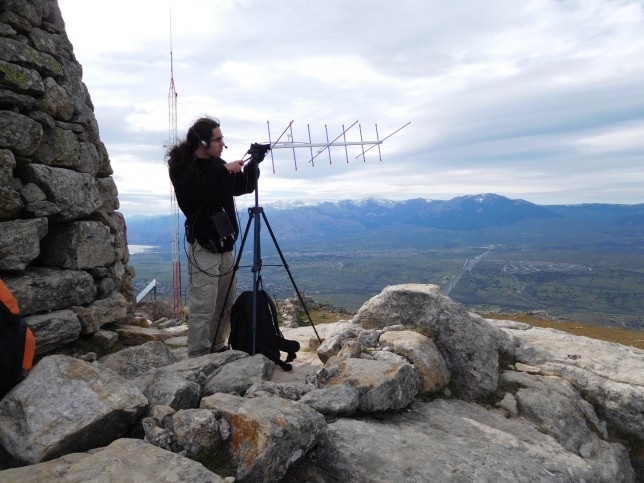Yesterday, my father and I hiked to Cerro de San Pedro, SOTA summit EA4/MD-020 (1425m), to work QRP in this month’s national V-UHF contest: Concurso Costa del Sol. Since the forecast for Sunday was rainy, I decided to go up on Saturday’s afternoon. The summit is a short hike from a nearby road. We arrived to the summit around 14:25UTC, so I could work in the contest for a bit more than two hours until we started packing at 17:00UTC before it got too dark.
Activity seemed a little low, although this is not surprising, given that the national RTTY contest was also running at the same time. I also get the impression that there is more activity on Sunday mornings. Nevertheless, my results have been better than in March’s contest. I did fewer QSOs, but got more points and worked more DX. In fact, I could work almost everybody I heard. In the map below, as always, my location is marked in red, the stations in blue are those worked only in 144MHz and the ones in green where worked both in 144MHz and 432MHz.
The equipment I used was the usual: an FT-817ND and the arrow satellite yagi (3 elements on 144MHz and 7 elements on 432MHz). I had solved all the little problems that appeared during the previous contest, and everything worked just fine.
The only problem I had this time was reduced output power on 432MHz according to the FT-817ND’s power meter. I’m now looking into this issue, but this problem could have existed for months, because it’s probably being a long time since I last checked this. However, it wasn’t much of a problem. The radio was probably putting out at least one or two watts. Of all the stations that I worked on 144MHz and had 432MHz, I only failed to work on 432MHz one, EB3JT, and it was because I could barely hear them on this band.

When we reached the summit, we found a little surprise: some kind of radio station is installed there. You can see it behind me in the picture above. The installation consists of a tower which is several meters high, a vertical antenna on top of it (perhaps some collinear antenna) and a small UHF yagi in the vertical polarization towards the bottom of the mast (if I recall correctly, it is three elements and points towards the south-west). Everything seems to run from three large solar panels and all the equipment is housed in a concrete structure. This station made some amount of QRM both on 144MHz and 432MHz. It could be heard as broadband noise almost all the time. Nothing too terrible, because the noise seemed to be vertically polarized, but a bit annoying nevertheless. I wonder what’s the purpose of this station. I’ve tried to look it up on the Internet, but so far I’ve found nothing. Perhaps it’s related to the railway service, as a long tunnel for the AVE Madrid-Segovia-Valladolid high-speed train runs below the mountain. The railway track for this line can also be seen in the picture above.
